OUTPUT VIEW
The OUTPUT view contains the mixing and dynamics controls for Mariana. The SUMMING section allows you to mix and pan both SYNTH 1 and SYNTH 2 as well as apply dynamic compression to the sum. It also contains meters for visual indication of left and right RMS levels, stereo correlation, and compressor gain reduction. The EFFECTS sections allow you to apply effects separately to SYNTH 1 and SYNTH 2 – with DELAY for SYNTH 1, CHORUS for SYNTH 2, and independent SATURATION for both.
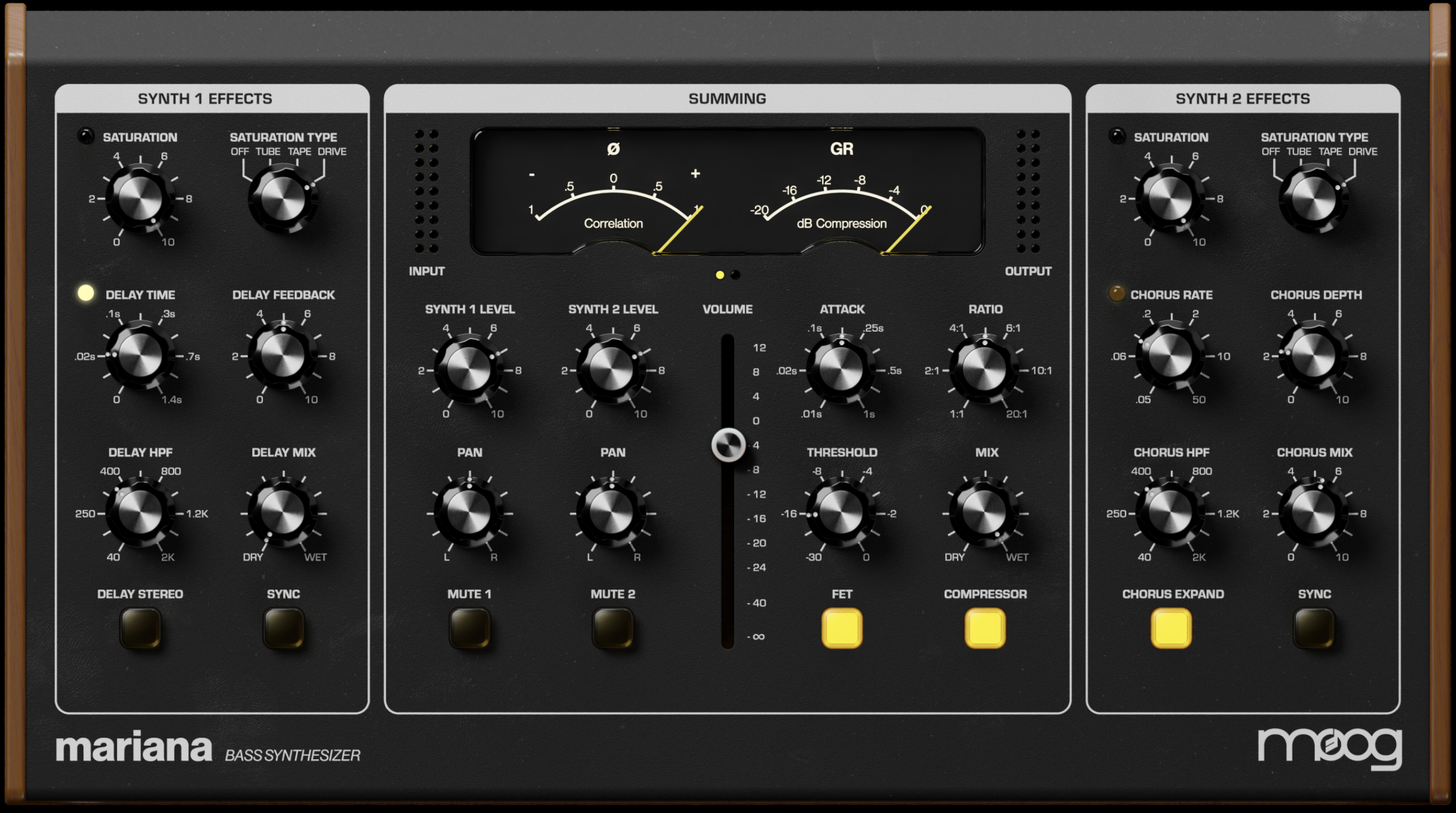
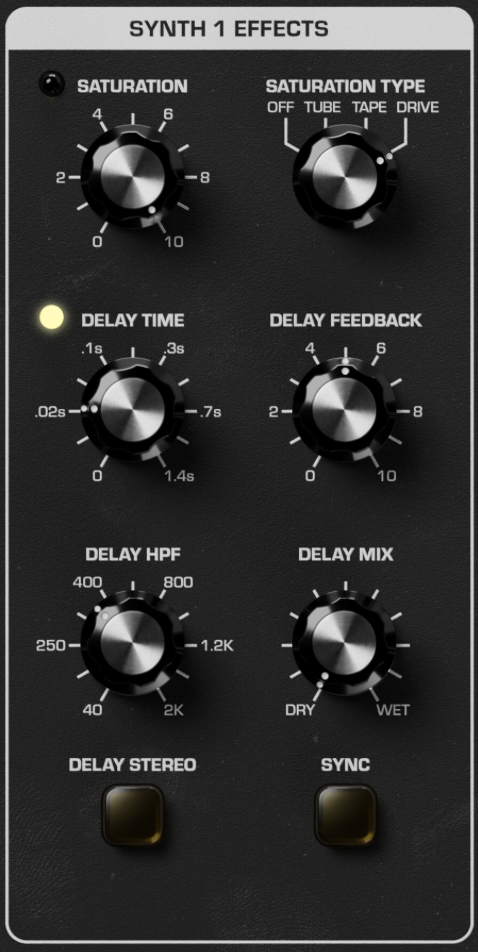
SYNTH 1 EFFECTS
Saturation adds both a volume boost and tonal grit by overdriving the input signal. Mariana features a saturator with three different types of vintage saturation which will all add unique distortion to your sound.
SATURATION – Adjusts the amount of SATURATION applied to SYNTH 1.
SATURATION TYPE – Switches between three SATURATION types:
OFF: Saturation is turned off.
TUBE: Emulates an overdriven vacuum tube, such as those used in guitar amplifiers or tube-based hi-fi systems.
TAPE: Emulates saturation that comes from recording too loud onto magnetic tape.
DRIVE: Emulates analog transistor-based overdrive.
Delay will delay the input sound and repeat it at a certain time later and is useful for adding musical echoes to your sound. Mariana’s delay is optimized for bass sounds, with a high-pass filter (HPF) for only delaying higher-frequency components so that your bass tones can still hit hard and precise while the top end gets pleasing delay treatment.
DELAY TIME – Sets the delay time for SYNTH 1’s delay effect – from 0 seconds to 1.4 seconds. When SYNC is enabled the time divisions will display around the knob.
DELAY FEEDBACK – Sets the amount of delay output fed back to the input. Feedback is variable from no feedback through slapbacks up to continuous repeats. At maximum setting feedback will not be infinite but will be very long.
DELAY HPF – A gentle high-pass filter on the input to the delay section and in the feedback path, allowing you to add delay only to higher frequencies while leaving lower frequencies unaffected.
DELAY MIX – Crossfader blending between the dry signal and the delayed (‘wet’) signal.
TIP: Modulate this with the MOD ENVELOPE to increase the amount of delay over the duration of a note!
DELAY STEREO – Activates a ping-pong mode, pinging the delay between the left and right channels.
SYNC – Synchronizes the DELAY TIME to multiplications or divisions of your project’s current tempo, an external MIDI clock, or Mariana’s own internal tempo. Multiples/divisions will display around the RATE knob.
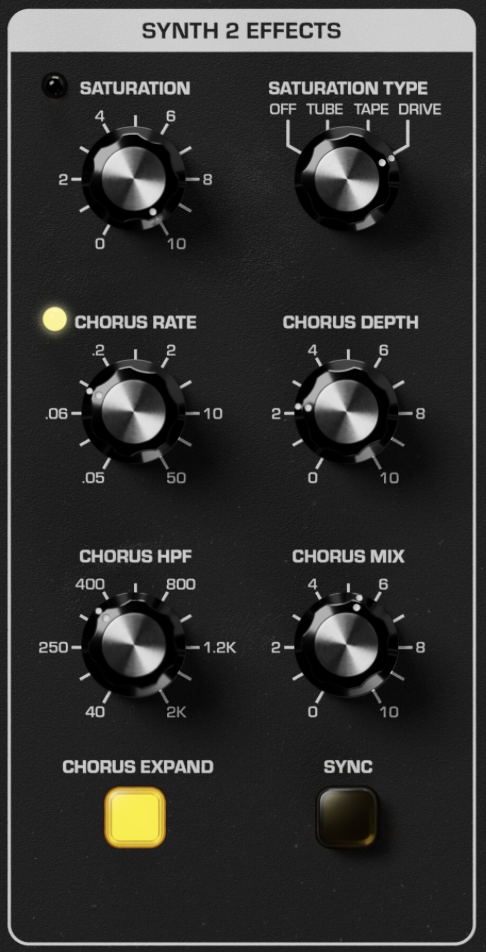
SYNTH 2 EFFECTS
SATURATION – Adjusts the amount of SATURATION applied to SYNTH 2.
SATURATION TYPE – Switches between three SATURATION types:
OFF: Saturation is turned off.
TUBE: Emulates an overdriven vacuum tube, such as those used in guitar amplifiers or tube-based hi-fi systems.
TAPE: Emulates saturation that comes from recording too loud onto magnetic tape.
DRIVE: Emulates analog transistor-based overdrive.
Chorus is a specific type of delay effect that uses very short delay times with modulation of the delay time to mimic the sound of multiple instruments sounding at once. Chorus is a very useful effect to thicken up and add swirling depth to a sound.
CHORUS RATE – Sets the rate of chorusing for SYNTH 2’s chorus effect – from 0.5 Hz to 50 Hz. When SYNC is enabled the time divisions will display around the knob.
TIP: Modulate this with the MOD ENVELOPE for an increasingly fast chorus effect over the duration of a note!
CHORUS DEPTH – Sets the depth of the chorus effect, with subtle chorusing at lower settings and very exaggerated motion at higher settings.
CHORUS HPF – A gentle high-pass filter on the input to the chorus section as well as in the feedback path, allowing you to add chorus only to higher frequencies while leaving lower frequencies unaffected.
CHORUS MIX – Dry/wet control for the chorus, blending the chorused (‘wet’) signal into the dry signal.
CHORUS EXPAND – Expands the space and depth of the chorus effect.
SYNC – Synchronizes the CHORUS RATE to multiplications or divisions of your project’s current tempo, an external MIDI clock, or Mariana’s own internal tempo. Multiples/divisions will display around the RATE knob.
SUMMING
Summing is the final stage in Mariana before the output. It brings together both SYNTHs via a mixer, sets a master output VOLUME, and contains the COMPRESSOR for adding glue and extra control over the dynamics of your sounds. It also contains METERS for visual inspection of the final stereo output from Mariana.

METERS
Mariana contains multiple meters for visual indication of different aspects of your sound, allowing you to dial your sound in precisely. By default the Ø and GR meters are shown – clicking on the meters will switch to the L/R meters.
Ø (Correlation) - The Correlation meter displays the phase difference between the left and right channels. When the Correlation meter reads +1 the left and right channels are fully in phase and your sound will play back correctly when summed to mono. If the Correlation meter is at –1 the left and right channels are out of phase and you will encounter phase cancellation issued when your signal is summed to mono. At 0 the left and right channels are uncorrelated indicating a very wide stereo signal where mono compatibility is questionable.
TIP: It is generally a good rule to aim for the correlation meter to be mostly in the 0 to +0.5 range, which indicates some stereo width but largely a mono compatible signal. All the way to the right in the +0.5 to +1.0 range and your sound will be a mostly mono signal with little stereo information, which can be useful for bass sounds that really need to cut through.
GR (dB Reduction) - The GR meter shows the amount of gain reduction applied by the compressor in decibels (dB). For more information see the compressor section below.

L/R (dB RMS) - The Left and Right meters show the RMS level of the left and right channels individually, allowing you to diagnose any imbalances in your stereo image.
NOTE: Mariana’s RMS meters use the K-14 scale, providing 14 dB of headroom with 0 dB set to –14 dB FS.
INPUT – A stereo meter showing the RMS level of the sum of both SYNTHs coming into the SUMMING section.
OUTPUT – A stereo meter showing the RMS output level post SUMMING.
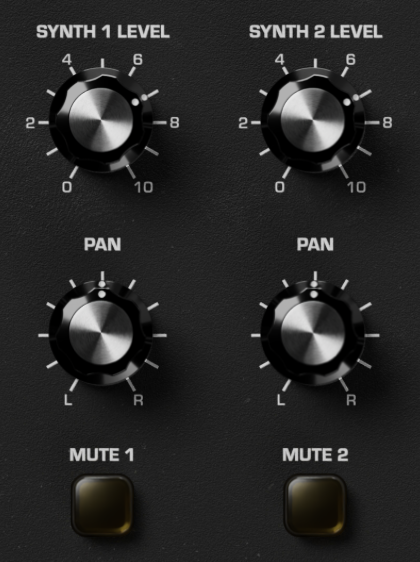
MIXER
Each SYNTH has controls for the volume of the SYNTH, a PAN pot for stereo placement of each SYNTH, and a MUTE switch for each SYNTH.
SYNTH 1 / 2 LEVEL – Sets the level of each SYNTH in the final mixers – post-effects but before the COMPRESSOR.
PAN – Pan pot for stereo placement of each SYNTH – from fully LEFT to fully RIGHT. Centered with PAN at noon.
MUTE – Switch to fully mute each SYNTH.
TIP: When using Mariana in Duophonic mode please make sure that both synth levels are high enough and that neither is muted. The notes you play with be played by either synth layer, and if one is silent that may mean you need to raise its level in the Mixer.
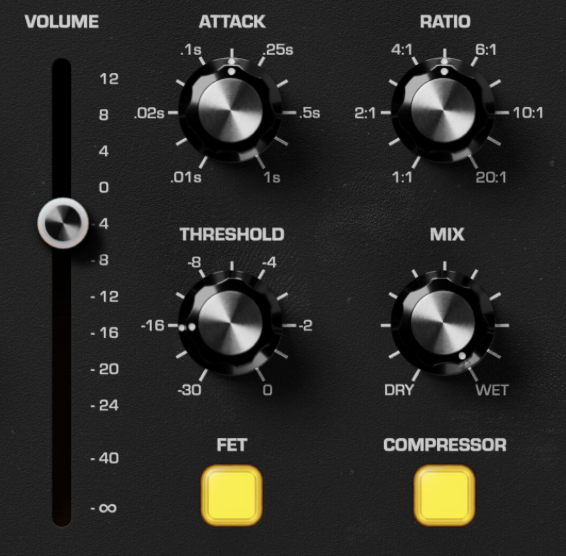
COMPRESSOR
A compressor is a device that responds to an incoming signal and actively turns the volume down if the signal goes above a certain THRESHOLD. Compressors are used to add dynamic punch to a sound by reducing the dynamic range.
ATTACK – Sets the attack time for the compressor to engage after the input goes above the level set by THRESHOLD. Attack time ranges from nearly instantaneous (0.01 seconds) up to 1 second.
RATIO – Sets the ratio at which the signal is compressed above the THRESHOLD. At 1:1 no compression is applied, whereas at 4:1 the strength of the signal above the THRESHOLD is one quarter of what it otherwise would be. At maximum strength (20:1) the portion of the signal above the THRESHOLD is reduced to one twentieth of what it otherwise would be, nearly limiting the output level to be the same as the THRESHOLD level.
THRESHOLD – Sets the level at which compression begins in decibels (dB). Includes intelligent auto-gain compensation to keep your sounds from dropping in volume.
MIX – A crossfader mixing the dry signal with the compressed (‘wet’) signal.
FET – Enables emulation of an analog FET compressor with feedback introduced in the compressor.
COMPRESSOR – Turns the compressor on and off.
VOLUME – Slider which controls the final volume output of Mariana post compressor.